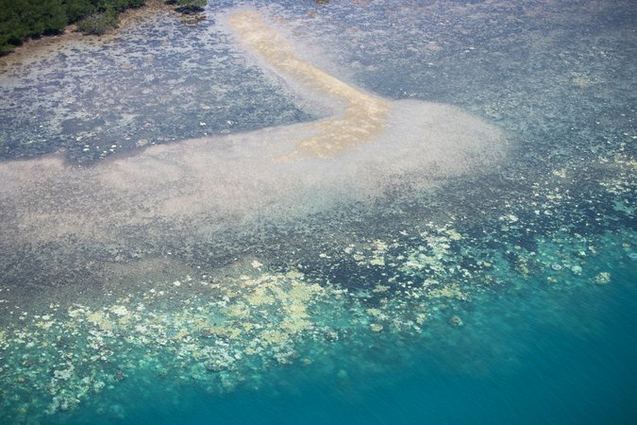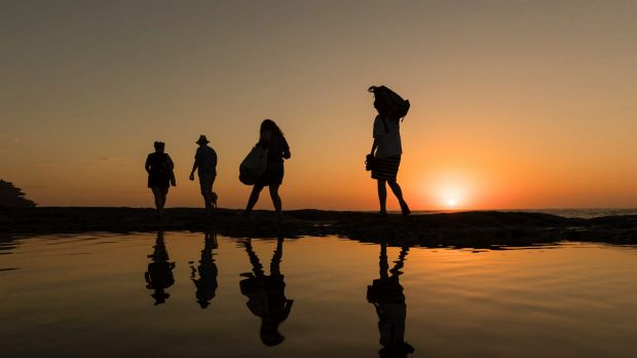Antarctica’s ice shelves are melting from warming ocean waters below—even during seasons when snowfall on top of them is increasing. This strange paradox could worsen from the natural climate phenomenon El Niño, according to a study published Monday in Nature Geoscience. Based on 23 years of satellite data from the West Antarctic ice shelves, the study revealed that a strong El Niño event causes the shelves to lose more ice from melting beneath than they gain back from snowfall on top of it.
 |
| Sea ice floats as seen from NASA's Operation IceBridge research aircraft in the Antarctic Peninsula region, on November 4, 2017, above Antarctica. Getty |
El Niño causes snowfall to increase, especially in the Amundsen Sea sector. Though the snowfall increases the actual height of this ice shelf, El Niño events cause wind patterns in Antarctica to push warmer ocean waters towards the ice shelf, which results in the basal melting.
The satellite data from 1994 to 2017 revealed the height of the ice decreased by eight inches per year overall from ocean melting, according to the study. But during the El Niño event in 1997 and 1998, the height increased by 10 inches. The fresh snowfall, however, is much less dense than the solid ice that makes up most of the shelf. The mass, which is the most important measurement in terms of sea level rise, was decreasing although the height increased during the event. The extra snowpack was minimal compared to how much solid ice melted from below. Ice shelves lost five times more ice from below than they gained back from fresh snowfall.
 |
| Sea ice is viewed aboard NASA's research aircraft in the Antarctic Peninsula region, on November 3, 2017, above Antarctica. Getty |
El Niño and La Niña are the two phases of the climate cycle called El Niño—Southern Oscillation (ENSO). The cycle is influenced by the tropical Pacific waters’ temperatures, which alternate between warmer-than-average during El Niño and cooler-than-average during La Niña.
Satellite records over two decades allowed researchers to look at the processes that affect ice shelves, which helps scientists better understand how ice sheets may melt in the future. Understanding the processes behind the melting of ice shelves could help pinpoint how soon and how much sea levels will rise. Ice shelves don’t cause sea level rise on their own. Rather, the ice sheets they hold back from slipping and melting into ocean water hold the fate of coastal communities around the world in their icy grip. Ice shelves, Paolo described, function like an ice cube.
 |
| Ice floats near the coast of west Antarctica as viewed from a window of a NASA Operation IceBridge airplane on October 28, 2016, in-flight over Antarctica. Getty |
Ice shelves are already vulnerable to calving off large ice chunks. Last July, an iceberg the size of Delaware broke off the Larsen C ice shelf. How those ice shelves work with the ice sheets and glaciers are what directly relates to making more precise sea level projections. Helen Fricker, Paolo's Ph.D. adviser at the time of the study and glaciologist at Scripps, said in a statement: "The holy grail of all of this work is improving sea level rise projections."
Links
- Melting Glaciers in East Antarctica Are Unstable
- Iceberg off West Antarctica Glacier Disintegrates
- Large Climate Change Expedition To Set Sail For Antarctica
- Watch A Delaware-Size Iceberg Break Off Antarctica And Float Away In An Incredible New Animation
- Ice Apocalypse
- Geologists Just Discovered 260-Million Year Old Forests In Antarctica
- In Antarctica, Two Crucial Glaciers Accelerate Toward The Sea
- Fears For Colony Of 18,000-Penguins That Bred Only Two Chicks
- Giant Hole Opens Up In Antarctica As Scientists Look To Find Out What Is To Blame
- More Daytime Images Of The Larsen C Iceberg Have Come In, And They're Amazing
- 'Attacked From Two Sides': Antarctic Sea Ice Hits Another Record Low
- How Antarctic Ice Melt Can Be A Tipping Point For The Whole Planet’s Climate
- The Larsen C Ice Shelf Collapse Is Just the Beginning—Antarctica Is Melting
- Greenland's Meltwater Is Raising Sea Level Faster Now
- Oxygen Is Disappearing From the World's Oceans











